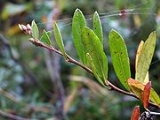
Chamaedaphne
Encyclopedia
The Leatherleaf is a shrub
in the plant family Ericaceae
and the only species in the genus Chamaedaphne. It has a wide distribution throughout the cool temperate and subarctic regions of the Northern Hemisphere
.
It is a low-growing shrub
up to 1.5 m tall. The leaves
are alternately arranged on the branch and elliptical to oblong shaped, 3–4 cm long, thick and leathery, with minute scales and lighter coloration on the underside, and an entire or irregularly toothed margin. They are evergreen
but often turn red-brown in winter. The flower
s are small (5–6 mm long), white, and bell-like, produced in panicle
s up to 12 cm long. The species site is restricted to bogs, where they naturally form large clonal colonies
.
The name Chamaedaphne comes from the Greek
for "ground laurel"; the common name comes from its tough, leather-like leaf.
Leatherleaf is used as a food plant by the larva
e of some Lepidoptera
species including Coleophora ledi
.
Shrub
A shrub or bush is distinguished from a tree by its multiple stems and shorter height, usually under 5–6 m tall. A large number of plants may become either shrubs or trees, depending on the growing conditions they experience...
in the plant family Ericaceae
Ericaceae
The Ericaceae, commonly known as the heath or heather family, is a group of mostly calcifuge flowering plants. The family is large, with roughly 4000 species spread across 126 genera, making it the 14th most speciose family of flowering plants...
and the only species in the genus Chamaedaphne. It has a wide distribution throughout the cool temperate and subarctic regions of the Northern Hemisphere
Northern Hemisphere
The Northern Hemisphere is the half of a planet that is north of its equator—the word hemisphere literally means “half sphere”. It is also that half of the celestial sphere north of the celestial equator...
.
It is a low-growing shrub
Shrub
A shrub or bush is distinguished from a tree by its multiple stems and shorter height, usually under 5–6 m tall. A large number of plants may become either shrubs or trees, depending on the growing conditions they experience...
up to 1.5 m tall. The leaves
Leaf
A leaf is an organ of a vascular plant, as defined in botanical terms, and in particular in plant morphology. Foliage is a mass noun that refers to leaves as a feature of plants....
are alternately arranged on the branch and elliptical to oblong shaped, 3–4 cm long, thick and leathery, with minute scales and lighter coloration on the underside, and an entire or irregularly toothed margin. They are evergreen
Evergreen
In botany, an evergreen plant is a plant that has leaves in all seasons. This contrasts with deciduous plants, which completely lose their foliage during the winter or dry season.There are many different kinds of evergreen plants, both trees and shrubs...
but often turn red-brown in winter. The flower
Flower
A flower, sometimes known as a bloom or blossom, is the reproductive structure found in flowering plants . The biological function of a flower is to effect reproduction, usually by providing a mechanism for the union of sperm with eggs...
s are small (5–6 mm long), white, and bell-like, produced in panicle
Panicle
A panicle is a compound raceme, a loose, much-branched indeterminate inflorescence with pedicellate flowers attached along the secondary branches; in other words, a branched cluster of flowers in which the branches are racemes....
s up to 12 cm long. The species site is restricted to bogs, where they naturally form large clonal colonies
Clonal colony
A clonal colony or genet is a group of genetically identical individuals that have grown in a given location, all originating vegetatively from a single ancestor. In plants, an individual in such a population is referred to as a ramet...
.
The name Chamaedaphne comes from the Greek
Ancient Greek
Ancient Greek is the stage of the Greek language in the periods spanning the times c. 9th–6th centuries BC, , c. 5th–4th centuries BC , and the c. 3rd century BC – 6th century AD of ancient Greece and the ancient world; being predated in the 2nd millennium BC by Mycenaean Greek...
for "ground laurel"; the common name comes from its tough, leather-like leaf.
Leatherleaf is used as a food plant by the larva
Larva
A larva is a distinct juvenile form many animals undergo before metamorphosis into adults. Animals with indirect development such as insects, amphibians, or cnidarians typically have a larval phase of their life cycle...
e of some Lepidoptera
Lepidoptera
Lepidoptera is a large order of insects that includes moths and butterflies . It is one of the most widespread and widely recognizable insect orders in the world, encompassing moths and the three superfamilies of butterflies, skipper butterflies, and moth-butterflies...
species including Coleophora ledi
Coleophora
Coleophora is a very large genus of moths of the family Coleophoridae. It contains some 1,350 described species. The genus is represented on all continents, but the majority are found in the Nearctic and Palaearctic regions...
.

